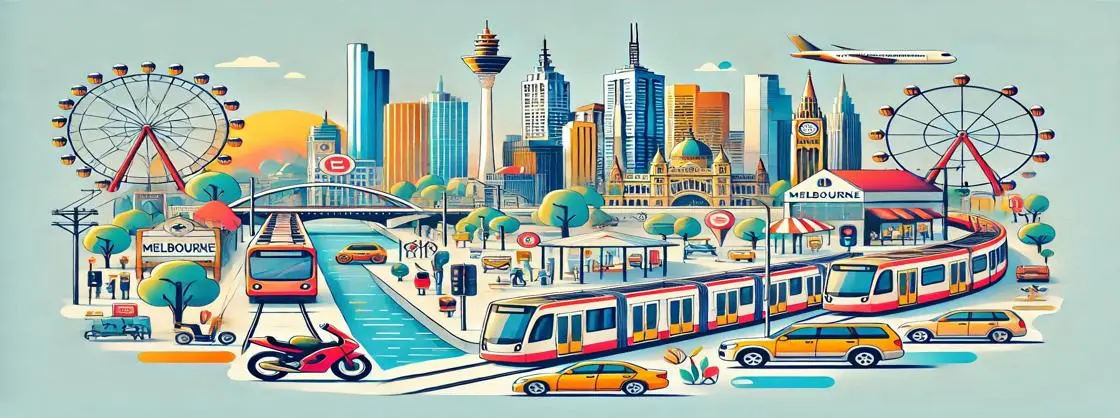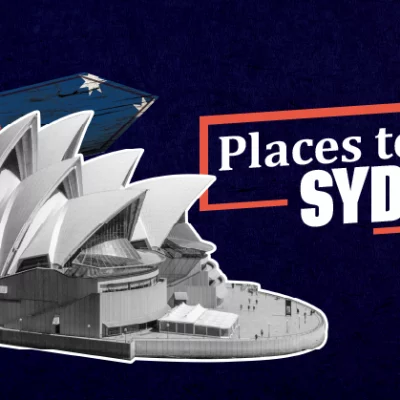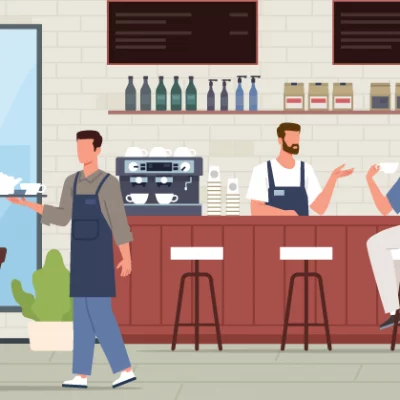Transportation in Melbourne: A Guide for International Students
Table of Contents
Melbourne, a city buzzing with culture and opportunity, is a haven for international students. Its efficient transportation system and student-friendly initiatives make navigating the city both convenient and affordable. From the iconic tram network to budget-friendly cycling routes, Melbourne ensures seamless connectivity for everyone. For international students managing the cost of living in Melbourne, understanding public transport options and money-saving strategies is essential for a stress-free experience.
Different Modes of Transportation in Melbourne
Navigating Melbourne is a breeze, thanks to its extensive and budget-friendly transportation network. Here’s an in-depth look at the available modes of transport, tailored to suit every lifestyle and budget:
Trams
Melbourne’s tram network is celebrated as the largest in the world, offering an efficient and budget-friendly way to navigate the city. Trams are a go-to mode of transportation for students, especially with the Free Tram Zone in the CBD, where travel costs nothing.
- This makes commuting to key attractions like Federation Square, Queen Victoria Market, and the Melbourne Museum hassle-free.
- For travel outside the Free Tram Zone, a 2-hour adult ticket costs AUD 4.60.
- Trams are environmentally friendly and ideal for short city trips, making them a popular choice among students and locals.
Trains
Melbourne’s train system connects the city center to its sprawling suburbs, making it a preferred option for longer commutes. With a daily cost of AUD 9.20 for Zone 1 and 2 travel using a Myki card, the train network offers affordability without compromising on speed.
- Key stations like Flinders Street, Southern Cross, and Melbourne Central ensure accessibility to major hubs.
- Trains operate from early morning until midnight, with extended services on weekends, making them an excellent choice for students balancing studies and leisure.
Buses
Melbourne’s bus system fills in the gaps left by trams and trains, ensuring comprehensive connectivity across the city. For AUD 4.60 for a 2-hour ticket, buses provide convenient access to outer suburbs, regional areas, and university campuses.
- Night buses operate on weekends, offering a safe and reliable option for late-night travel.
- Students living in areas not directly serviced by trams or trains often find buses an indispensable part of their daily commute.
Cycling
Cycling is a sustainable and cost-effective transportation choice for students in Melbourne. It not only reduces your carbon footprint but also promotes a healthy lifestyle, making it a favorite among eco-conscious students.
- With bike rentals starting at AUD 3 per day, cycling is perfect for short commutes and leisure rides.
- The city boasts dedicated bike lanes and scenic routes like the Yarra River Trail and Beach Road.
Ridesharing and Taxis
Ridesharing services like Uber, Ola, and Didi, along with traditional taxis, offer unmatched flexibility for students needing late-night or remote-area commutes.
- With costs averaging AUD 1.50–2.00 per kilometer, these services are ideal for group travel or when public transport isn’t an option.
- Occasionally, ridesharing platforms offer discounts, making them a more affordable choice during promotional periods.
Ticketing System Used in Melbourne
Navigating Melbourne’s transport system is seamless, thanks to the Myki card—a reusable smart card designed to simplify travel across all public transportation modes. For students, the Myki card offers affordability, convenience, and access to discounted fares.
1. What is a Myki Card?
The Myki card is Melbourne’s all-in-one prepaid travel card designed for seamless transportation across trams, trains, and buses. It eliminates the hassle of buying individual tickets for each journey, making it a convenient and essential tool for navigating Melbourne’s public transport system. Following are the types of Myki Card:
- Full Fare: For regular adult passengers.
- Concession: Designed for students, seniors, and other eligible groups, offering significant fare discounts.
- Child: Tailored for younger travelers under 16 years old, ensuring affordability for families.
Whether you’re a local commuter or an international student, the Myki card provides a hassle-free and cost-effective travel solution.
2. How to Get a Myki Card
Getting a Myki card is straightforward and widely accessible, making it easy to start your Melbourne travel adventures. You can buy this card at train stations, Convenience stores like 7-Eleven or can order it online via the official Myki website. The initial set up cost for it is AUD 6. You can also do top-ups whenever required.
3. Student Discounts
Students, both international and domestic, can enjoy significant savings on Melbourne’s public transport system by applying for a Myki Concession Card. Below is the eligibility criteria to get student discounts:
- Must be a full-time student enrolled in a Victorian educational institution.
- Proof of enrollment and student ID may be required during the application process.
4. How to Use a Myki Card
Using a Myki card is designed to be simple and user-friendly, ensuring a smooth journey every time. To use your card, you have to tap your Myki card on a reader at the start of your trip and again when you leave the vehicle or station. This calculates the fare based on your travel zones. Within Melbourne’s CBD Free Tram Zone, travel is free, and no tapping is required. This is perfect for short trips to popular attractions like Federation Square or Flinders Street Station.
Cost of Travel in Melbourne
Melbourne’s public transport system, managed by Public Transport Victoria (PTV), includes trams, trains, and buses, which collectively provide seamless connectivity across the city and its suburbs. Below is a summary of public transport costs in Melbourne to help you plan your expenses better:
| Mode of Transport | Cost | Key Features |
| Trams | Free in CBD; AUD 4.60 (2 hrs) | Iconic, extensive network in Melbourne |
| Trains | AUD 4.60 (2 hrs); AUD 9.20 cap | Ideal for long-distance commutes |
| Buses | AUD 4.60 (2 hrs) | Covers outer suburbs and regional areas |
| Cycling | AUD 3+ per day | Healthier, eco-friendly option |
For students using public transport regularly, investing in a Myki card is a must. With a daily fare cap of AUD 9.20, frequent travelers enjoy cost savings.
Cost of Living in Melbourne
The cost of living in Melbourne can vary depending on your lifestyle and accommodation preferences. However, Melbourne remains a popular destination due to its quality of education, vibrant city life, and employment opportunities. Here’s a breakdown of the average monthly expenses in Melbourne:
| Expense Category | Cost (AUD) |
| Accommodation | 250–600 (weekly range) |
| Food | 320–480 |
| Transportation | 150–200 (Myki fares) |
| Utilities | 150–200 |
| Health Insurance | 40–50 |
| Entertainment | 50–100 |
How to Save Money on Public Transport as an International Student
International students can save significantly on transport costs in Melbourne with the right strategies and tools. Following are the tips to save money on transport as an international student:
- Apply for a Myki Concession Card: Eligible students can enjoy 50% discounts on fares, reducing daily caps and single-trip costs.
- Use the Free Tram Zone: Take advantage of free travel within the CBD for commutes to central landmarks, universities, or student accommodation in Melbourne.
- Invest in Travel Passes: Weekly or monthly travel passes are ideal for regular travelers, offering unlimited rides at a flat rate.
- Plan Off-Peak Travel: Traveling during off-peak hours ensures less crowded public transport and may reduce wait times.
- Cycle for Short Distances: Renting or owning a bike is cost-effective for short trips and promotes a healthier lifestyle.
- Group Travel Discounts: Some services, like ride sharing or carpooling, provide reduced fares for groups—great for weekend trips with friends.
Conclusion
Melbourne’s well-connected public transport system, combined with cost-saving options like the Myki Concession Card and the Free Tram Zone, makes it an ideal city for international students. With proper planning, students can explore the vibrant cityscape and its attractions without overspending, ensuring a balanced and enjoyable study experience.
Frequently Asked Questions
How much does transportation cost in Australia for international students?
Travel costs in Australia vary based on the mode of transport:
- Single bus/train ticket: AUD 10.
- Monthly public transport pass: AUD 100–AUD 200.
- Domestic flight (one-way): AUD 200–AUD 300.
How can tourists use public transport in Melbourne?
Tourists in Melbourne need a Myki card to travel outside the Free Tram Zone. These cards are available at retail outlets, train stations, and visitor centers. Load money onto your Myki to use trains, trams, and buses.
Is tram travel free for students in Melbourne?
Children, school students, and eligible international undergraduate students in Melbourne can enjoy free or discounted travel. Concession fares are 50% of full fares.
Do students get free public transport in Australia?
Yes, eligible school and TAFE students in Australia benefit from the School Student Transport Scheme (SSTS), which offers free or subsidized travel across NSW on trains, buses, ferries, and light rail.
Which trams in Melbourne are free?
The Free Tram Zone in Melbourne covers major landmarks like Queen Victoria Market, Docklands, Flinders Street Station, and Federation Square. The City Circle Tram also offers free unlimited rides.
Which city is the cheapest for international students in Australia?
Gold Coast tops affordability rankings in Australia, offering lower tuition fees and living costs compared to other cities, as ranked by QS Student Cities 2025.







